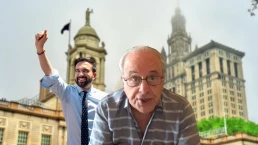On Wednesday, Governor Hochul outlined several major climate promises in her State of the State address including accelerating offshore wind development, decarbonizing millions of homes and spurring the adoption of electric vehicles throughout the state.
By Mark Armao, Grist
New York’s new Governor, Kathy Hochul, is charting an ambitious course toward reaching the state’s emission-cutting goals. On Wednesday, Governor Hochul outlined several major climate goals in her State of the State address including accelerating offshore wind development, decarbonizing millions of homes and spurring the adoption of electric vehicles throughout the state.
The commitments are intended to help the state meet goals set by the 2019 Climate Leadership and Community Protection Act, or CLCPA, which requires the state to cut its net emissions to zero by 2050. The law also requires that New York generate 70 percent of its electricity through renewable sources by the end of this decade.

Building on the state’s investments in offshore wind energy in recent years, Hochul announced a $500 million investment to advance the nascent industry while creating more than 2,000 green jobs. The state plans to procure new wind projects capable of generating at least 2 gigawatts of electricity — enough to power 1.5 million homes. In the coming months, New York will start construction on the state’s first offshore wind project, the South Fork Wind Farm.
“With this investment, New York will lead the nation on offshore wind production, creating green jobs for New Yorkers, and powering our clean energy future,” Hochul said. “We must harness the potential of offshore wind to fuel our economy forward and meet our ambitious climate goals.”
Governor Hochul said she will propose legislation that would require all new buildings to have zero on-site emissions by 2027. If passed, New York would be the first state to enact such legislation, essentially banning the use of gas for heating buildings, which account for more than one-third of the state’s climate pollution.
Recent Posts
“Arrest Now, Ask Questions Later”: Why Did L.A. ICE Agents Arrest and Jail U.S. Citizen Andrea Velez?
July 3, 2025
Take Action Now “They didn’t have vests that said ICE or anything. Their cars didn’t have license plates. … Just because of the color of our…
Trump’s Big, Beautiful Bill Is Naked Class War
July 3, 2025
Take Action Now Trump’s “Big, Beautiful Bill” trades tax cuts on millionaires for the dissolution of society.By Hamilton Nolan, In These Times…
Mayor Mamdani’s First Day, A Zero Hour Conversation With Richard Wolff
July 2, 2025
Take Action Now If elected, what would Mayor Mamdani do on his first day in City Hall? How would a democratic socialist govern as a big-city mayor?……
The U.S. Is Funding A Bloodbath At Gaza Aid Centers
July 2, 2025
Take Action Now The admin just gave $30M to GHF, the organization at the center of charges that Israel is weaponizing assistance and shooting at…




